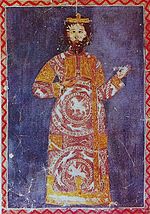John Komnenos the Fat
John Komnenos (Latinized as Comnenus), nicknamed "the Fat" (Greek: Ἰωάννης Κομνηνὸς ὁ παχύς, romanized: Ioannis Komninos o pahys), was a Byzantine noble who attempted to usurp the imperial throne from Alexios III Angelos in a short-lived coup in Constantinople on 31 July 1201 (or 1200).
With the support of the capital's populace, the plotters managed to seize most of the Great Palace in Constantinople's southeastern corner, which the mob proceeded to loot, and John Komnenos was crowned in the Hagia Sophia.
[4] The reign of Alexios III Angelos (r. 1195–1203) had been troubled from the outset: the aristocracy conspired against him, his pressing demand for new sources of revenue was blocked by the refusal of Senate, clergy and merchants to contribute, while the lower and middle classes of the imperial capital frequently displayed their discontent with riots against corrupt officials.
[5][6] John Komnenos was a rather unimportant figure in the court, and in a marginal note dating to the late 13th century, Alexios Doukas Mourtzouphlos, who briefly became emperor during Constantinople's final siege by the Fourth Crusade, was named as the real mastermind behind the coup.
This much is evident from the — albeit embellished — account of the eyewitness Nicholas Mesarites, whereby John Komnenos's supporters proclaimed that henceforth everything would go well for Romania, that her enemies would be vanquished, and that the kings of all the earth would come to pay homage to Constantinople.
They even reached the Nea Ekklesia and the Church of the Virgin of the Pharos, the Empire's chief depository of holy relics, which was defended by its skeuophylax, Nicholas Mesarites, with a small guard provided by John Komnenos.
It was led by the emperor's son-in-law Alexios Palaiologos, who at that point was likely regarded as his heir-apparent, and quickly made contact with the Varangians who had held out in the palace's northern parts, around the Chalke Gate.
[3][17] John's coup was written extensively about by contemporaries: the historian Niketas Choniates deals with it briefly and rather dismissively, but Nicholas Mesarites left a long eyewitness account of events, in which his own role is suitably emphasized.

